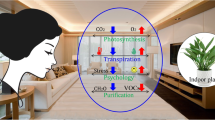Abstract
The emission of terpene compounds from vegetation is subject to seasonal and diurnal variations. Due to oxidation of terpene compounds simple aldehydes like formaldehyde can be formed. Insofar formaldehyde is an ubiquitous chemical. Due to its high reactivity it has a short half-life time.
Wood and wood-based panels emit a low, but still detectable, amount of formaldehyde. The emission depends on exogenic (temperature, relative humidity, air exchange level) and endogenic (wood species, binder level, binder type, production conditions, etc.) factors.
With the aging of boards formaldehyde release declines tremendously to reach very low level. Nevertheless, with low fuming binders wood-based panels with formaldehyde emission close to that of untreated wood can be prepared.
Non-formaldehyde volatile organic compounds (VOCs) can be released from wood and wood-based panels. The emission rate depends on the wood species as well as on the boundary conditions (drying, storage, etc.). In the case of wood-based panels it depends also on the production factors as well as on the storage conditions. Methods to assess VOCs have been developed and regulations regarding the limits of emission values are under way.
Zusammenfassung
Die Freisetzung von Terpenen aus der Vegetation hängt von der Tages- und Jahreszeit ab. Durch Oxidation bilden sich aus den Terpenverbindungen einfache Aldehyde wie Formaldehyd. Insoweit entsteht Formaldehyd auch durch Reaktionen, die in der Natur stattfinden. Wegen seiner hohen Reaktivität hat Formaldehyd eine kurze Halbwertzeit.
Holz und Holzwerkstoffe geben geringe, aber dennoch nachweisbare, Mengen an Formaldehyd ab. Die Emission von Formaldehyd hängt von einer Reihe endogener (Holz, Bindemittelanteil, Produktionsbedingungen, etc.) und exogener (Temperatur, relative Luftfeuchte, Luftwechselzahl, etc.) Faktoren ab.
Die Freisetzung von Formaldehyd nimmt durch Alterung von Holzwerkstoffen erheblich ab. Mit den heutigen Bindemitteln lassen sich Holzwerkstoffe herstellen, deren Formaldehydabgabe der von unbehandeltem Holz weitgehend entspricht.
Weitere flüchtige organische Verbindungen (VOCs) können aus Holz und Holzwerkstoffen in geringen Mengen entweichen. Die Emissionsrate hängt von der Holzart ab und ist je nach Lagerungs- und Trocknungsbedingungen unterschiedlich. Bei den Holzwerkstoffen ist sie auch von den Produktionsfaktoren sowie von den Lagerungsbedingungen abhängig. Methoden zur Erfassung flüchtiger organischer Verbindungen wurden entwickelt und Bestimmungen zur Festlegung von Grenzwerten werden derzeit erarbeitet.
Similar content being viewed by others
References
AgBB (Juli 2004) Vorgehensweise bei der gesundheitlichen Bewertung der Emissionen von flüchtigen organischen Verbindungen (VOC und SVOC) aus Bauprodukten. Ausschuss zur gesundheitlichen Bewertung von Bauprodukten
Boehme C (2000) Über die Formaldehydabgabe von Holz und ihre Veränderung während technischer Prozesse der Holzwerkstoffherstellung, Dissertationsschrift. Shaker Verlag, Aachen
Devos M et al. (1990) Standardised human olfactory thresholds. Oxford University Press, New York, pp 28–141
Dix B, Roffael E, Schneider T. (2004) Abgabe von flüchtigen Verbindungen (Volatile Organic Compounds, VOC) von Strands, hergestellt aus Kern- und Splintholz der Kiefer. WKI-Kurzbericht 6/2004, WKI short report 6/2004
Dix B, Roffael E, Schneider T. (2004) Einfluss der Lagerung auf die Bildung und Abgabe von flüchtigen organischen Verbindungen. WKI-Kurzbericht 7/2004, WKI short report 7/2004
Dunky M (2004) Challenges with formaldehyde based adhesives. In: Proceedings Cost E 34 – Innovation Conference in Wood Adhesives on 04.11.2004 in HSB, Biel, Switzerland, pp 115–126
Marutzky R, Roffael E (1977) Über die Abspaltung von Formaldehyd bei der thermischen Behandlung von Holzspänen. Holzforschung 31:8–12
Marutzky R (1998) Volatile organische Verbindungen (VOC) aus Holzwerkstoffen und Möglichkeiten der Verminderung. In: Proceedings Fachtagung Umweltschutz in der Holzwerkstoffindustrie, June 24,25 1998, Göttingen, pp 131–142
McDonald AG et al. (2004) Air emission from timber drying: high temperature drying and redrying of CCA – treated timber. Holz Roh- Werkst 62(4):291–302
Risholm-Sundman M et al. (1998) Emission of acetic acid and other volatile organic compounds from different species of solid wood. Holz Roh- Werkst 56:125–129
Roffael E (1993) Formaldehyde release from particleboard and other wood-based panels. Malayan Forest Records 37. ISBN 983-9592-15-7
Schäfer M, Roffael E (2000) On the formaldehyde release of wood. Holz Roh- Werkst 58:259–264
Sharp JG (2004) Formaldehyde – The big issue. In: Proceedings of the 8th European Panel Symposium, Llandudno, Wales, UK, October 13–15 2004, pp 2-1-25 (ISBN 1842200712)
Sundin B, Roffael E (1989) Einfluss der Alterung auf die Formaldehydemission von UF-Spanplatten niedrigen Formaldehydabgabepotentials. Holz-Zentralblatt 115(47):704
Sundin B, Risholm-Sundman M, Edenholm K (1992) Emission of formaldehyde and other volatile organic compounds (VOC) from sawdust and lumber, different wood-based panels and other building materials. A comparative study. In: 26th International Particleboard/Composite Materials Symposium, Washington State University, Pullman, USA, April 7–9 1992
Author information
Authors and Affiliations
Corresponding author
Rights and permissions
About this article
Cite this article
Roffael, E. Volatile organic compounds and formaldehyde in nature, wood and wood based panels. Holz Roh Werkst 64, 144–149 (2006). https://doi.org/10.1007/s00107-005-0061-0
Published:
Issue Date:
DOI: https://doi.org/10.1007/s00107-005-0061-0




